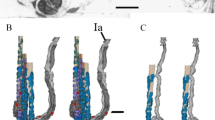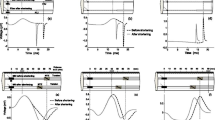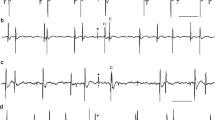Abstract
Muscle spindle stretch responses (cat gastrocnemius muscles) were studied when bothsteady stretch andsmall near-threshold random stretch determined the Ia impulse sequence. Statistical properties of the inter-impulse-intervals gave some insight into the Ia encoder mechanism. Superimposed random stretch of mean velocitiesσ vel below 5 mm s−1 did not change the mean discharge rate, but the width of the Ia interspike interval distribution was clearly increased. Raising the stretch velocity further (σ vel > 5 mm s−1) led to an additional increase in the distribution width, finally reaching values of 0.6 for the coefficient of variation. The shapes of the impulse interval histograms changed from symmetrical to positively skewed ones. The 1st order serial correlation coefficient of the interval sequence shifted to slightly more negative values with increasingσ vel; on the average, ther 1,2-value varied between zero and −0.2. The data were discussed in relation to current ideas on the mechanism of impulse initiation in the Ia terminal ending. They provide evidence that a combination of multiple encoder sites located in the myelinated terminal branches and a separate pathway for large static and small-amplitude dynamic stretch is not very likely. A model is proposed as to how the whole tree of myelinated axons functions as a single encoder site.
Similar content being viewed by others
References
Banks RW (1986) Observations on the primary sensory ending of the tenuissimus muscle spindles in the cat. Cell Tissue Res 246:309–319
Barker D (1974) The morphology of muscle receptors. In: Hunt CC (ed) Handbook of sensory physiology, vol III/2:Muscle receptors. Springer, Berlin Heidelberg New York, pp 1–190
Boyd IA (1976) The mechanical properties of dynamic nuclear bag fibres, static nuclear bag fibres and nuclear chain fibres in isolated cat muscle spindles. Progr Brain Res 44:33–50
Boyd IA (1981) The action of three types of intrafusal fibre in isolated cat muscle spindles on the dynamic and length sensitivities of primary and secondary sensory endings. In: Taylor A, Prochazka A (eds) Muscle receptors and movement. Macmillan, London, pp17–32
Boyd IA (1985) Review. In: Boyd IA, Gladden MH (eds) The muscle spindle. M Stockton Press, London New York, pp 129–150
Brokensha G, Westbury PR (1974) Adaptation of the discharge of frog muscle spindles following a stretch. J Physiol 242:383–403
Brown MC, Engberg I, Matthews PBC (1967) The relative sensitivity of vibration of muscle receptors of the cat. J Physiol 192:773–800
Buller AJ (1985) A model illustrating some aspects of muscle spindle physiology. J Physiol 179:402–416
Buller AJ, Nichols JG, Ström G (1953) Spontaneous fluctuations of excitability in the muscle spindle of the frog. J Physiol 122:409–418
Eagles JP, Purple RL (1974) Afferent fibers with multiple encoder sites. Brain Res 77:187–193
Eysel UT (1971) Computer simulation of the impulse pattern of muscle spindle afferents. Kybernetik 8:171–179
French AS, Stein RB (1970) Flexible neural analog using integrated circuits. IEEE Trans Biomed Eng 17:248–253
Geisler CD, Goldberg JM (1966) A stochastic model of the repetitive activity of neurons. Biophys J 6:53–69
Gregory JE, Harvey RJ, Proske U (1977) A ‘late supernormal period’ in the recovery of excitability following an action potential in muscle spindle and tendon organ receptors. J Physiol 271:449–472
Grüsser O-J, Höhne-Zahn H, Jahn SA, Pellnitz K (1973) The encoding of the receptor potential into impulse patterns of muscle spindle afferents of cats. In: Gydikov AA, Tankov NT, Kosarov DS (eds) Motor control. Plenum Press, New York, pp 15–32
Holden AV (1976) Models of the stochastic activity of neurons. Springer, Berlin Heidelberg New York, p 368
Hulliger M, Noth J (1979) Static and dynamic fusimotor interaction and the possibility of multiple pace-makers operating in the cat muscle spindle. Brain Res 173:21–28
Hunt CC, Wilkinson RS (1985) Passive and active properties of mammalian intrafusal fibres. In: Boyd IA, Gladden MH (eds) The muscle spindle. Stockton Press, London New York, pp151–152
Ito F, Kanamori N, Kuroda H (1974) Structural and functional asymmetries of myelinated branches in the frog muscle spindle. J Physiol 241:389–405
Jami L, Petit J, Scott JJA (1985) Driving of spindle primary endings by static β axons. In: Boyd IA, Gladden MH (eds) The muscle spindle. Stockton Press, London New York, pp 201–205
Kröller J, Grüsser O-J, Weiss L (1985) The response of primary muscle spindle endings to random muscle stretch: a quantitative analysis. Exp Brain Res 61:1–10
Kröller J, Grüsser O-J, Weiss L-R (1988) Observations on phaselocking within the response of primary muscle spindle afferents to pseudo-random stretch. Biol Cybern 59:49–54
Lennerstrand G (1968) Position and velocity sensitivity of muscle spindles in the cat. I. Primary and secondary endings deprived of fusimotor activation. Acta Physiol Scand 73:281–299
Matthews PBC, Stein RB (1969) The regularity of primary and secondary muscle spindle afferent discharges. J Physiol 202:59–82
Mizote M (1976) Effects of FM vibration on muscle spindles in the cat. Progr Brain Res 44:133–140
Ottoson D (1976) Morphology and physiology of muscle spindles. In: Llinas R, Precht W (eds) Frog neurobiology. Springer. Berlin Heidelberg New York, pp 643–670
Paintal AS (1959) Facilitation and depression of muscle stretch receptors by repetitive antidromic stimulation, adrenaline and asphyxia. J Physiol 148:252–266
Perkel DH, Gerstein GL, Moore GP (1967) Neural spike trains and stochastic point process. Biophys J 7:391–418
Poppele RE, Quick DC (1981) Stretch induced contraction of intrafusal muscle in cat muscle spindles. J Neurosci 1:1069–1074
Quick DC (1986) Acute lesion of the intrafusal muscle of muscle spindles: ultrastructural and electrophysiological consequences. J Neurosci 6:2097–2105
Quick DC, Kennedy WR, Poppele RE (1980) Anatomical evidence for multiple sources of action potentials in the afferent fibers of muscle spindles. Neuroscience 5:109–115
Rall W (1977) Core conductors theory and cable properties of neurons. In: Brookhart JM, Mountcastle VB, Kandel ER, Geiger SR (eds) Handbook of physiology, Sect. 1:The nervous system, vol I. American Physiological Society, Bethesda, pp 39–98
Sokolove PG (1972) Computer simulation of after-inhibition in crayfish slowly adapting stretch receptor neuron. Biophys J 12:1429–1459
Stein RB (1967) Some models of neuronal variability. Biophys J 7:37–68
Author information
Authors and Affiliations
Rights and permissions
About this article
Cite this article
Kröller, J., Grüsser, O.J. & Weiss, L.R. A study of the encoder properties of muscle-spindle primary afferent fibers by a random noise disturbance of the steady stretch response. Biol. Cybern. 63, 91–97 (1990). https://doi.org/10.1007/BF00203030
Received:
Accepted:
Issue Date:
DOI: https://doi.org/10.1007/BF00203030




